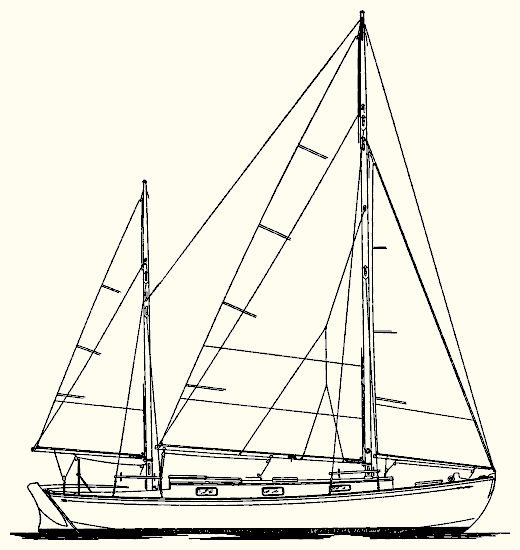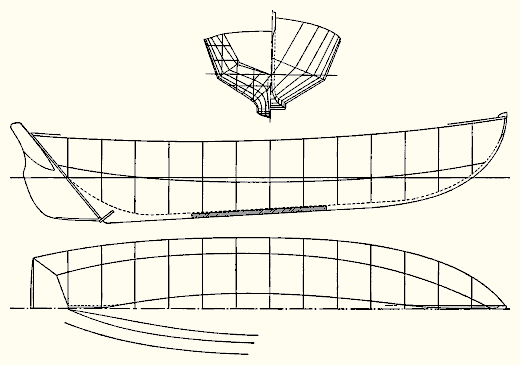

Should you care to look back through the files of MoToR BoatinG there will be found in the issue of September, 1946, designs of the rough water open boat Brent; and in the text mention is made to the effect that the little V bottom was named in honor of a very young man who lives at Tarboro, North Carolina, the text going on to say, "One of these days with the coming of spring Brent's father will sail away from these Connecticut shores bound South in a 36-foot by 11-foot beam, by 3-foot draft Matthews Sailer type ketch-rigged auxiliary now under construction in an inland boat shop at New Canaan, Conn. And perhaps one of these fine days, the fates willing, the plans of the ketch will appear in MoToR BoatinG." Brent's father, Pembroke Nash, owned one, of the original Matthews Sailers. The Nash family outgrew the 25-foot Sailer which, by the way, was named Sunnie, and for this reason Mr. Nash asked, me to design a larger edition and one having comfortable accommodations for four children and two grown-ups. This work was taken in hand, the contract for the building of the boat let, and in good time the little vessel was launched and "sailed away from these Connecticut shores." Like the 25 footer, the larger sister was named Sunnie

The plans of the new Sunnie show a very wholesome type of cruising yacht; ketch rigged with jibhead sail plan and this all inboard. She is 36 feet 4 inches on deck; 31 feet, on the water line; has a breadth of 11 feet; and draws 3 feet 6 inches of water with all ballast and equipment aboard. When launched and outfitted she rested within an inch of her designed water line, and for the full length of the water line. The freeboard at the bow is 4 feet 7 1/2 inches; the least freeboard is 2 feet 9 1/8 inches; and the freeboard at the stern is 3 feet 3 3/8 inches. The displacement of Sunnie is 17,900 pounds and she carries 5,500 pounds of lead in her keel and has inside ballast weighing 2,000 pounds.
Sunnie is simply rigged. The total sail area is 509 square feet divided as follows: Mainsail, 205 square feet; mizzen, 98 square feet; and staysail, 115 square feet. The standing rigging is of the simplest form; two shrouds each side for both main and mizzen masts; main topmast back stay leading to the hounds of the mizzen mast; head stay and main topmast stay. All to be of plain, wholesome and long lasting galvanized iron rigging wire. There are no mast spreaders or struts and for a cruising yacht of this particular kind these are not required.
The deck plan shows a cockpit which is 6 feet long with a bridge deck 14 inches wide spanning the hull between the cockpit and the after end of the cabin trunk. The bridge deck is needed because it ties the hull together and provides the strength needed to prevent the hull from wringing and spreading. The trunk cabin is 18 feet long and of sufficient height to permit the fitting of marine windows each side and forward as well. The waist decks are 20 1/2 inches wide amidships and increase in width forward of this point to about 24 inches; and decrease to 18 inches at the cockpit. This gives fine foot room all around the boat something that is sadly neglected in many otherwise excellent sailing and motor boats. There is a hatch in the forward deck; one on the trunk cabin deck and of course the standard companion slide leading below from the bridge deck.

The arrangement below shows a large open cabin. This has the galley, which by the way is 6 feet 2 inches long, in the after starboard side. Galley is fitted with two-burner alcohol stove, ice box, 12 inch by 18 inch sink, and ample shelves and lockers for dishes, supplies, etc. A 6 foot 7 inch long extension berth fills the space between the galley and the toilet room. There are two transom built-in berths along the port side of the cabin; these have lockers below, and there is a long shelf as shown above. A large toilet room, this is 3 feet 9 inches long and completely fitted with fixed wash basin, pump water closet, and lockers, opens from the passageway between the cabin and forward stateroom. Across the passage there is a big hanging locker. The forward stateroom has full headroom in its after end, good size hanging lockers and two full length and width built-in berths. The forepeak is given over to stowage space for anchor chain and such things as always collect aboard a cruising yacht. There is really a great deal of room below decks on Sunnie, plenty of room in which to live and, as Mrs. Nash writes, "She has certainly proved her commodious comfort, too."
The auxiliary motor fits under the cockpit floor abaft the after cabin bulkhead. The plan shows a 25-45 h.p. Red Wing four cylinder motor. However, because of shortages of crank cases, gears, or some other thing when the boat was built, the Red Wing was not available and so the owner installed a Kermath Sea Prince; a motor of greater length and power than the one shown on the plans. Despite the greater length of the Sea Prince it fitted into the boat very well without having to extend into the cabin.

A study of her lines indicates a hull that can be pushed at much higher speeds than the more usual fat round bilge models; she has easy fore and aft lines, rather flat chines and therefore buttock lines that enter and leave the water with a minimum of disturbance. She is well balanced and the deadrise from bow to stern has perfect continuity; it is this latter feature which accounts for her excellent performance both under sail and power. The sections above the line of the chines have unusual flare and the boat has more than her share of stability. Thanks to the drag in the keel and the large rudder, Sunnie comes about in light or heavy weather and will not find herself in irons. The body plan shows the influence of the Seabright skiff; but the flat double-ended keel has much less breadth in proportion to the width of the deck than is ever found in the boats that made Seabright famous. In addition to the ease with which hulls of this model may be propelled, the flat keel makes grounding a simple matter and hauling out a safe and easy process. She will not upset if left to herself on land, or for that matter afloat. While the ketch has unusual breadth for her overall length, she does not look like a beamy boat, nor is she high sided.